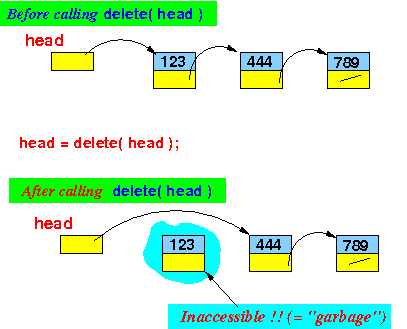- We will write the following
function:
- ListElem* insertHead(
ListElem* head,
ListElem* elem):
- Inserts the list element
elem
into the list head
at the start of the list
- The function returns the address (reference) of the head element of the new list
- Inserts the list element
elem
into the list head
at the start of the list
- ListElem* insertHead(
ListElem* head,
ListElem* elem):
- Previously, we have seen how to insert a new
list element at the start of a list:
/* ======================================================== Insert at head technique: 1. create new list element p put values in the payload area... 2. make p point to first element in list 3. make head point to new list element ======================================================== */ p = malloc( sizeof(struct ListElem) ); // (1) p->value = 123; // Payload... p->next = head; // (2) head = p; // (3)We just need to put these statements into a function
- Function that insert a
new list element at start of
a list:
struct ListElem* insertHead(struct ListElem* head, struct ListElem* elem) { elem->next = head; // make "elem" point to "head" return(elem); // return address of new head }
- Example Program:
(Demo above code)

- Prog file: click here
How to run the program:
- Right click on link(s) and
save in a scratch directory
- To compile: gcc insert-list2.c
- To run: ./a.out
- Java's way to delete the
first element from
a linked list:
List delete ( List head ) { return( head.next ); // Make the second element the new head }
- Why this
will not work in C:
- The deleted linked list elements
becomes garbage (inaccessible):

- What will happen sooner or later:
- Eventually (after many deletions), the computer memory will become exhausted
- When computer memory is
exhausted
(no more unused memory cells),
the Java run time system will
invoke the
garbage collector
and reclaim the inaccessible
memory cells
- In a C program, when
computer memory is
exhausted,
the C program will
crash
(because C does
not have any
garbage collector)
- You (the C programmer) is responsible for the un-reserving of memory cells used for storing the deleted list elements !!!!
- The deleted linked list elements
becomes garbage (inaccessible):
- Syntax to un-reserve
memory cells:
free( pointerVariable ) ;
Effect:
- The memory cells pointed to by the pointerVariable are un-reserved.
- Example:
int main(int argc, char *argv[]) { struct BankAccount* p; p = malloc( sizeof(struct BankAccount) ); // (1) (*p).accNum = 123; // Long form to access a member variable p->balance= 400; // Short form to access a member variable printf("p->accNum = %d p->balance = %f\n", p->accNum, p->balance); /* ================================================== Unreserve memory that was allocated at step (1) ================================================== */ free(p); }
- How to delete
an element from a linked list
in C:
- First,
do what you have learned
(in CS170) to delete
the
element from the linked list
- Before you delete the element from the linked list (i.e., before the element become inaccessible) record the address of the deleted list element !!!
- Then, use the address that you have saved in the previous step to un-reserve the memory cells for the deleted list element
- First,
do what you have learned
(in CS170) to delete
the
element from the linked list
- Example: delete the
first element from
a linked list (in C)
struct ListElem* deleteHead ( struct ListElem* h ) { struct ListElem* deleted; struct ListElem* newHead; if ( h == NULL ) return(NULL); // Nothing to delete.... deleted = h; // Save the location of the deleted element newHead = h->next; // We will return this value free(deleted); // Un-reserve memory cells return( newHead ); // Make the second element the new head }
- Example Program:
(Demo above code)

- Prog file: click here
How to run the program:
- Right click on link(s) and
save in a scratch directory
- To compile: gcc delete-list1.c
- To run: ./a.out
- Deleting from tail or from
any position in the linked list
will not be discussed in this course.
I don't want to waste time teaching you deleting from linked list again....
You just apply what you have learned in CS170 to delete the list element; but make sure you save the address (reference) of the deleted element
Then use the free( deleted_element ); statement to un-reserve the memory cells used before the function return.